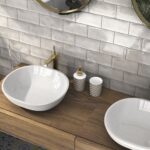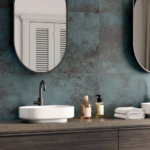A common question we get asked here at Bridport Glass and Tile Centre is whether floor tiles can be used for wall applications. So, we’re here to set the record straight.
We’ll explain which tiles can be used where and how you can buy the right tiles to suit your next project.
So, let’s dive straight into it and explore the difference between wall and floor tiles and answer your burning questions.
So, Can You Use Floor Tiles on Walls?
The simple answer is yes: you can apply any tile to your wall. However, if the tile isn’t fit for purpose, and is too heavy for your wall, then it will fall, either over time or almost immediately.
Also, floor tiles that aren’t fit to be applied to your walls can cause damage to your property, so it’s important that you choose the right tiles for your project.
That’s why providers like us offer wall tiles that are specifically designed to adhere safely to your wall and give you a pristine finish that lasts.
If you’ve got your heart set on using floor tiles on your walls, then you can, but you need to make sure you select the right ones.
How Do You Know Whether or Not a Tile Can Be Used on Walls?
The easy way to tell if a floor tile can be used on walls is to ask the person selling it to you! The team here at Bridport Glass and Tile Centre will be happy to explain which tiles will work on walls and which are best left on the floor.
All of our tile product pages also list whether the tile you’re looking at is suitable for walls, floors, or both, so be sure to check before you make your purchase.
What is the Difference Between Wall and Floor Tiles?
To the untrained eye, wall and floor tiles probably look exactly the same. However, there are many key differences, which become more noticeable after the tiles have been laid for some time.
These are some of the main differences between wall and floor tiles and what they mean for your project.

1) Tile Durability
The main factor that separates tiles made specifically for floors and walls is durability.
As floors have people walking on them all day and are used to stand heavy pieces of furniture on, a floor tile needs to be hard-wearing and designed to carry a lot of weight.
Tiles for walls, on the other hand, are used purely for decoration, meaning that they don’t need to be as durable. That means that wall tiles are often thinner and aren’t designed for as much wear as floor tiles.
2) Slip Resistance
Flooring tiles need to be slip resistant (for the most part), as they are being walked on regularly and might be prone to sliding around.
As such, most tiles designed for use on the floor have anti-slip coatings, particularly those that are used in bathrooms and other areas where the floor might be wet and hard to get purchase on.
As wall tiles are decorative and won’t be walked on, there’s no need for anti-slip coatings on them, and these coatings can reduce the shine and glossy finish that so many buyers enjoy.
That’s why most wall tiles aren’t anti-slip, which can be a downside if you intend to use them on your floors.
3) Tile Thickness
The thickness of the tiles you use will affect how durable they are and how much sound resistance they provide on your floor.
Most tiles used on floors are thicker than wall tiles, as they are made to withstand more wear and to insulate the floor against loud sounds. Tiles made for use on walls tend to be thinner, as they are only used to decorate the wall and cover it, much like wallpaper.
4) Design and Aesthetics
When it comes to tile designs, there’s not much of a difference between floor and wall tiles.
Both types of tiles come in various different shapes, sizes, colours and finishes – it really depends on the look you’re going for. You might want to mix and match different tiles to create an interesting pattern, or you can opt for a uniform look by using the same tile for both floor and walls.

5) Installation Considerations
As floor tiles are usually heavier than wall tiles, there are installation differences that need to be taken into account.
Many floor tile products are larger and heavier than wall tiles, so they might need two people to lift and place them correctly.
On the other hand, smaller tiles for walls are generally easier to install or lay, as they can be lifted and placed by one fitter.
What About Using Wall Tiles on the Floor?
Again, tiles made for walls could, theoretically, be used on your floor, but it depends entirely on the type of tile you have chosen.
As floors require a more robust tile due to the heavy footfall and furniture that they have to endure, you need to find strong tiles that are able to withstand a lot of wear.
Most wall tiles are decorative, meaning that they’re often thinner and less durable than tiles that are specifically designed for use on the floor. If you have a flooring space that gets less use and thicker wall tiles, then the project might work.
For thinner tiles, your floor might look good for a few days, but the wall tiles will start to crack under pressure and might move around, as they’re not designed for use on the floor.
So, where possible, you should try to find stronger tiles for your flooring project, which usually means exploring ones specifically designed for use on floors.

The Verdict: Can You Use Floor Tiles on Walls?
Ultimately, you can use some types of floor tile on your walls. However, you need to make sure that they are light enough, and given that there are hundreds of specially-designed wall tiles on the market, you should explore this range to see if there’s something more suitable available.
Our tile experts can guide you through our collections, which include dedicated kitchen and bathroom tiles so that you can find the right ones for every room in your home.
If you want inspiration for the next room to get a makeover, then our blog has loads of handy guides and practical tips from our tiling experts.
Have fun on your next home improvement project!
FAQs
Both tile types are similar but have some specific differences. Floor tiles tend to be strong to withstand greater footfall, while wall tiles can be more decorative and thinner as they won’t be walked on.
Wall tiles are lighter because they sit vertically on the wall, not horizontally on the ground. Many floor tiles also have anti-slip technology to keep them from sliding underfoot, while wall tiles don’t need this.
It is possible to use porcelain floor tiles on a wall if they are light enough, so consider thinner floor tiles for this purpose, or explore porcelain wall tiles. You’ll then be able to get the same look without the worry of the tiles causing damage to your walls.
There are several ways to get floor tiles to adhere to your walls, including using a tile backing board or a strong tile adhesive. If you have found some pretty patterned floor tiles and want to use them as wall art, you could also try framing them and securing them like you would a traditional picture.
While it is possible to use the same grout for wall and floor tiles, many homeowners choose to use sanded grout for floors, as it is more stable and less prone to slippage. For walls, you can use unsanded grout, which is less durable but will work well for thinner wall tiles.













